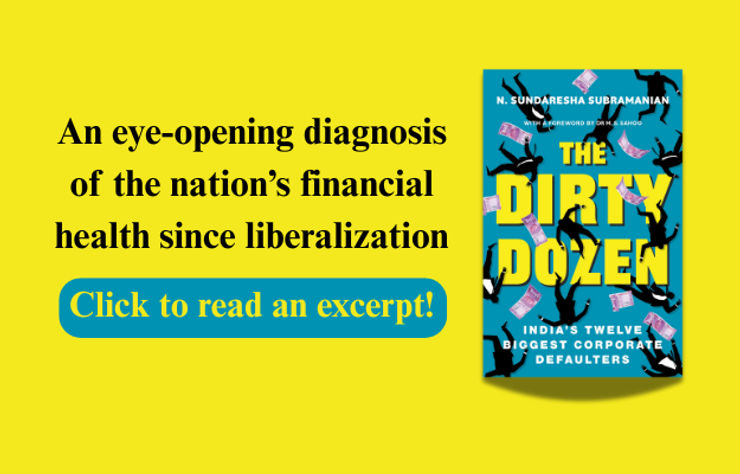India's Twelve Biggest Corporate Defaulters
Read an excerpt from The Dirty Dozen by N. Sundaresha Subramanian

READ AN EXCERPT
Electrosteel Steels
Many players in the steel industry have landed in trouble because of expanding capacities or diversifying into other sectors such as power. But this is the story of a ductile iron pipes company, also famous for supplying covers for manholes in New York, which it did by trying to venture into steel.
Electrosteel’s origins can be traced back to the business empire established by the Dalmia brothers – Ramkrishna and Jaidayal – in the pre-independence era. The Dalmia Bharat Group (DGB) owned several cement plants and other industries set up across British India. Post Independence, the brothers split and Jaidayal set up Dalmia Iron and Steel in 1955. The company was soon listed on the Calcutta Stock Exchange.
Ghanshyam Kejriwal, who was married to Uma Devi, Jaidayal Dalmia’s daughter, joined the company in the 1960s. At the time, the Dalmias were facing the wrath of the Nehru government, which did not have a great opinion of Ramkrishna, the then chairman of Times of India. He had once been described by Nehru as ‘an ugly man with an ugly face and an ugly mind and an ugly heart’. The Dalmia Group encountered issues with tax authorities, and Ramkrishna Dalmia was jailed in 1962 for tax evasion, perjury and criminal misappropriation of funds. This brush with politicians and law would be a recurring feature.
‘The Dalmia Group encountered issues with tax authorities, and Ramkrishna Dalmia was jailed in 1962 for tax evasion, perjury and criminal misappropriation of funds. This brush with politicians and law would be a recurring feature.’
A few years on, the iron and steel plant was incurring heavy losses. At one point, Jaidayal Dalmia decided to sell it, but as a last effort, he popped the question, ‘Ghanshyam, can you run it?’
For a moment, the man from Kanpur was perplexed. But egged on by his uncle and Jaidayal’s friend M. L. Goenka, Ghanshyam picked up the gauntlet. He had only one condition – that Dalmia would not enter the plant without him. The sonin-law was apprehensive that if the elderly man was around, he would not be able to get the employees on his side. Once the condition was accepted, there was no looking back. Old timers now reminisce about how Ghanshyam would reach the plant as early as six in the morning. He would give engineers on the shop floor a free hand. ‘I felt like a racehorse. If I run, I will win. That is the kind of confidence that it gave me,’ he would say.
The Dirty Dozen
by N. Sundaresha Subramanian
The sensational rise and shocking downfall of India's twelve largest corporate defaulters.
In June 2017, the Reserve Bank of India sent shockwaves through the nation as it disclosed a list of the country’s twelve biggest defaulters who were responsible for approximately a quarter of all bad loans in the Indian banking system. The alarming discovery of the ‘dirty dozen’ pulled back the curtain on the murky landscape of corporate irresponsibility and regulatory neglect, revealing the harsh reality of gross economic disparity, complacent governance and coordinated deceit.
In The Dirty Dozen, business journalist N. Sundaresha Subramanian investigates the cause and impact of India’s chronic bad loan issue. Recording the economic misadventures of Vijay Mallya, Nirav Modi and Jatin Mehta, among others, he lays bare the intricate maze of financial chaos, political plunder and malpractices that ail the country’s corporate landscape. In doing so, he makes an eye-opening diagnosis of the nation’s financial health since liberalization.
In a country where millions struggle for basic sustenance, The Dirty Dozen offers a brave, hard-hitting and much-needed exposé of crooked business moguls who have orchestrated deeply damaging financial manoeuvres and amassed millions, enjoying impunity nonetheless and leaving India’s economy teetering on the edge.
ABOUT THE AUTHOR

N. Sundaresha Subramanian is a business journalist and newsroom leader. With his rich experience in hard-hitting journalism and a keen focus on public interest, he has driven award-winning coverage in critical areas including corporate and regulatory affairs, corporate governance and wrongdoing, policy, geopolitics and emerging areas of ESG and energy transition. He lives and works in Delhi.
